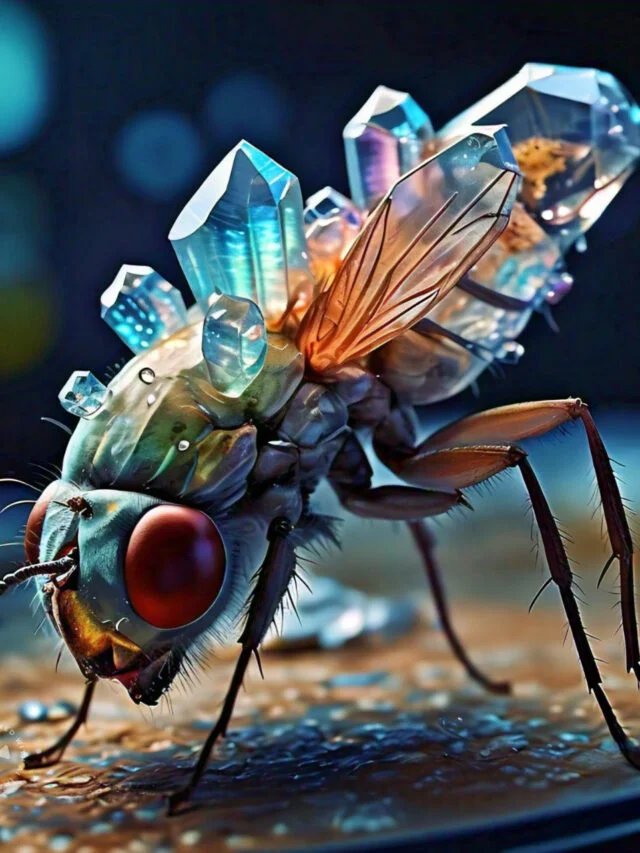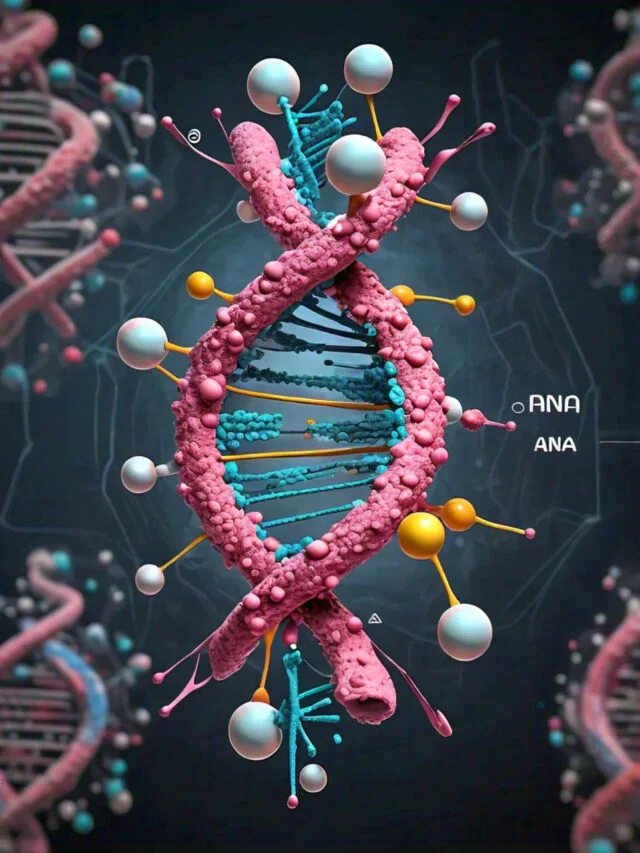What is Mendelian Inheritance?
- Mendelian inheritance, also referred to as Mendelism or Mendelian genetics, encompasses a crucial set of principles that elucidate the intricate process by which hereditary traits are transmitted from parents to their offspring. These principles, which underpin the foundation of genetics, were first conceived by Gregor Johann Mendel, an Austrian monk and botanist, and are heralded as the cornerstone of modern genetic understanding.
- Mendel’s groundbreaking investigations were carried out in the 19th century, using the unassuming garden pea plant (Pisum sativum) as his experimental subject. Through meticulous and methodical analyses, Mendel was able to identify and articulate the fundamental laws that govern the inheritance of traits from one generation to the next.
- Despite his pioneering contributions, Mendel’s work initially went unnoticed within the scientific community. It wasn’t until the early 20th century that his findings were rediscovered and duly acknowledged. This rediscovery occurred in 1900 through the efforts of Hugo de Vries and Carl Correns, leading to the rightful recognition of Mendel’s revolutionary insights. Subsequently, William Bateson played a pivotal role in popularizing Mendel’s principles.
- The principles of Mendelian inheritance were not without controversy at their inception. Nevertheless, the fusion of Mendel’s theories with the Boveri-Sutton chromosome theory of inheritance, skillfully accomplished by Thomas Hunt Morgan in 1915, marked a watershed moment. This integration solidified Mendel’s principles as the very essence of classical genetics, forming the bedrock upon which the field would evolve.
- A further significant development occurred when Ronald Fisher merged Mendel’s concepts with the theory of natural selection in his influential 1930 work, “The Genetical Theory of Natural Selection.” This synthesis established a mathematical framework for understanding evolution, giving rise to the domain of population genetics and contributing to the formation of the modern evolutionary synthesis.
- Genetics, the scientific study of heredity, owes its inception to the visionary work of Johann Gregor Mendel. He operated in an era when the intricacies of meiosis, chromosomes, and genes remained elusive. Yet, his careful selection of a simple biological system—garden peas—and his rigorous quantitative analyses, often conducted with substantial sample sizes, yielded profound insights. The legacy of Mendel’s endeavors resides in the recognition that genes, situated on chromosomes, constitute the fundamental functional units of heredity. These genes possess the remarkable capacity to be duplicated, expressed, and even altered through mutation.
- In the contemporary scientific landscape, Mendel’s postulates persist as the cornerstones of classical genetics. Although not all genetic traits adhere strictly to Mendelian inheritance patterns, his pioneering experiments remain an invaluable starting point for contemplating the complex intricacies of inheritance. Consequently, Mendelian genetics stands as a testament to the power of observation, experimentation, and the enduring pursuit of knowledge in the realm of biological science.
Terminology of Mendelian inheritance
The terminology of Mendelian inheritance provides a precise framework for understanding the transmission of hereditary traits from one generation to the next, based on Gregor Mendel’s groundbreaking work on the principles of genetics. This terminology encompasses key concepts that explain the relationship between genes, alleles, genotypes, and phenotypes:
1. Gene: A gene is a hereditary unit responsible for determining or influencing a specific trait in an organism. It consists of a particular sequence of DNA and is located on a specific region of a chromosome. This discrete genetic unit carries the information necessary for the development and expression of a trait.
2. Allele: An allele is a distinct variant or version of a gene. Just as chocolate and vanilla are specific variants of ice cream, alleles represent different versions of the same gene that may result in variations of a trait. For example, the gene responsible for eye color may have alleles for brown eyes and blue eyes.
3. Genotype: The genotype of an organism refers to the particular combination of alleles present in its DNA. It encompasses all the alleles an individual inherits from its parents. If an organism possesses two identical alleles for a specific gene, it is referred to as homozygous at that genetic locus. If an organism carries two different alleles for the same gene, it is heterozygous at that locus.
4. Phenotype: An organism’s phenotype represents its observable traits or characteristics, which result from the interaction between its genotype and the environment. Phenotypes can encompass a wide range of physical, physiological, and behavioral attributes.
5. Dominant Allele: A dominant allele is an allele that exerts its effect on the phenotype whether the organism is homozygous (carrying two identical alleles) or heterozygous (carrying two different alleles) for that gene. For instance, in humans, the allele for brown eyes is dominant over the allele for blue eyes. If an organism carries at least one dominant allele for a trait, that trait’s phenotype will be expressed.
6. Recessive Allele: A recessive allele is an allele that only manifests its effect on the phenotype when an organism is homozygous for that allele (carrying two identical recessive alleles). In a heterozygous individual with one dominant and one recessive allele, the phenotype will be determined by the dominant allele. Recessive alleles are often responsible for hidden or masked traits, and their expression is observed in individuals with two copies of the recessive allele.
7. Carrier: A carrier is an individual who possesses a recessive allele for a particular trait but does not express the associated phenotype. Carriers are typically heterozygous for the trait and have one dominant allele and one recessive allele. This concept is commonly associated with genetic diseases. Carriers can pass on the recessive allele to their offspring, potentially resulting in the expression of the trait in future generations.
Mendel’s meticulous observations and experiments led to the establishment of these fundamental genetic terms, providing a solid foundation for understanding how traits are inherited and expressed across generations. This terminology remains crucial in modern genetics as we continue to explore the intricacies of inheritance patterns and genetic variation.

Mendel’s Experiment
Gregor Mendel, the father of modern genetics, embarked on a series of pioneering breeding experiments between 1856 and 1863 with the intent of unraveling the intricate patterns of inheritance. He selected the common pea plant (Pisum sativum) as his experimental subject due to its various advantageous features: abundant variations in its varieties, the ability to self-pollinate, rapid life cycles, ease of cultivation, and distinct observable characteristics. Mendel’s endeavors centered on exploring seven specific traits inherent to pea plants: seed shape, seed color, flower color, pod shape, pod color, flower position, and stem height.
Mendel’s research culminated in two seminal experiments known as monohybrid and dihybrid crosses, which laid the foundation for understanding the laws of inheritance.
Monohybrid Cross
- In the monohybrid cross, Mendel delved into the inheritance patterns of a single trait. He crossbred pea plants that exhibited different variations of the same trait, such as tallness (TT) and dwarfness (tt), meticulously documenting their offspring’s traits. The parental generation (P) constituted the initial cross, with their offspring forming the first filial generation (F1).
- In the F1 generation, an intriguing outcome arose: all plants exhibited the dominant trait of tallness, while the recessive trait of dwarfness remained absent. This consistent display of the dominant trait in the F1 generation applied across all the traits Mendel scrutinized.
- Upon interbreeding the F1 plants, yielding the second filial generation (F2), a noteworthy shift emerged. Some offspring manifested the recessive trait that was absent in the F1 generation. Mendel observed a consistent ratio of 3:1 between the dominant and recessive traits within the F2 generation, regardless of the specific trait under consideration. This discovery indicated a systematic pattern that pervaded all the traits Mendel investigated.
Explanation of Monohybrid Cross
A monohybrid cross is a fundamental genetic experiment that involves the study of the inheritance patterns of a single trait between two individuals or sets of individuals. This type of cross provides insights into how specific traits are passed from parents to offspring and how different versions of a gene (alleles) interact within a population.
Here’s a step-by-step explanation of a monohybrid cross:
- Parental Generation (P): In this initial step, two individuals that differ in a particular trait are selected as parents. These individuals are referred to as the parental generation (P). For example, let’s consider the trait of seed color in pea plants. One parent could have yellow seeds (YY genotype, where Y represents the dominant allele), while the other parent could have green seeds (yy genotype, where y represents the recessive allele).
- Allele Combination: Each parent contributes one allele to the offspring for the trait being studied. In this example, one parent contributes a Y allele (for yellow seeds), and the other contributes a y allele (for green seeds).
- First Filial Generation (F1): The offspring resulting from the cross between the two parental individuals make up the first filial generation (F1). In a monohybrid cross, all the F1 offspring will inherit one dominant allele and one recessive allele for the trait under consideration. In our example, all F1 pea plants will have a genotype of Yy, which means they will exhibit the dominant trait (yellow seeds) due to the presence of the Y allele.
- Observation of Trait Expression: The F1 generation will express the dominant trait because the dominant allele (Y) masks the effects of the recessive allele (y). In our example, all F1 pea plants will have yellow seeds, regardless of whether they carry one or two copies of the dominant allele.
- Second Filial Generation (F2): To further understand the inheritance pattern, members of the F1 generation are allowed to mate with each other, producing the second filial generation (F2). This is where the interesting part happens.
- Trait Segregation in F2: When F1 individuals with the genotype Yy (heterozygous) are crossed with each other, their offspring in the F2 generation will exhibit a variety of genotypes and phenotypes. This is because during the formation of gametes, the alleles segregate, and each individual can pass on either the Y or y allele to their offspring.
- Phenotypic Ratio in F2: The F2 generation will display a specific phenotypic ratio that results from the combination of different genotypes. In a monohybrid cross, the phenotypic ratio is typically 3:1. This means that, on average, three-quarters of the offspring will exhibit the dominant trait, and one-quarter will display the recessive trait. In our example, for seed color, approximately 3/4 of the F2 pea plants will have yellow seeds, and 1/4 will have green seeds.
The monohybrid cross provides valuable insights into the Mendelian inheritance patterns of a single trait and demonstrates how the interaction of dominant and recessive alleles determines the expression of traits in offspring.
Dihybrid Cross
- The dihybrid cross marked Mendel’s exploration of the inheritance of two distinct traits. He mated purebred parental plants possessing different traits. For instance, he crossed plants with yellow, round seeds (YYRR) with plants exhibiting green, wrinkled seeds (yyrr).
- The outcome in the F1 generation was compelling: only the dominant traits of yellow color and round shape manifested in the offspring. As the experimental journey progressed to the F2 generation, a complex array of phenotypes unfolded. Four combinations of parental traits appeared in a phenotypic ratio of approximately 9:3:3:1. This pattern illustrated the independent assortment of the two studied traits, a phenomenon that highlighted the separability of traits during the process of inheritance.
Mendel’s experiments with monohybrid and dihybrid crosses revolutionized the understanding of inheritance, unraveling fundamental principles that continue to shape the field of genetics. His meticulous work laid the groundwork for comprehending the laws governing the transmission of traits from one generation to the next, ultimately birthing the modern field of genetics and illuminating the intricate mechanisms underlying the diversity of life.
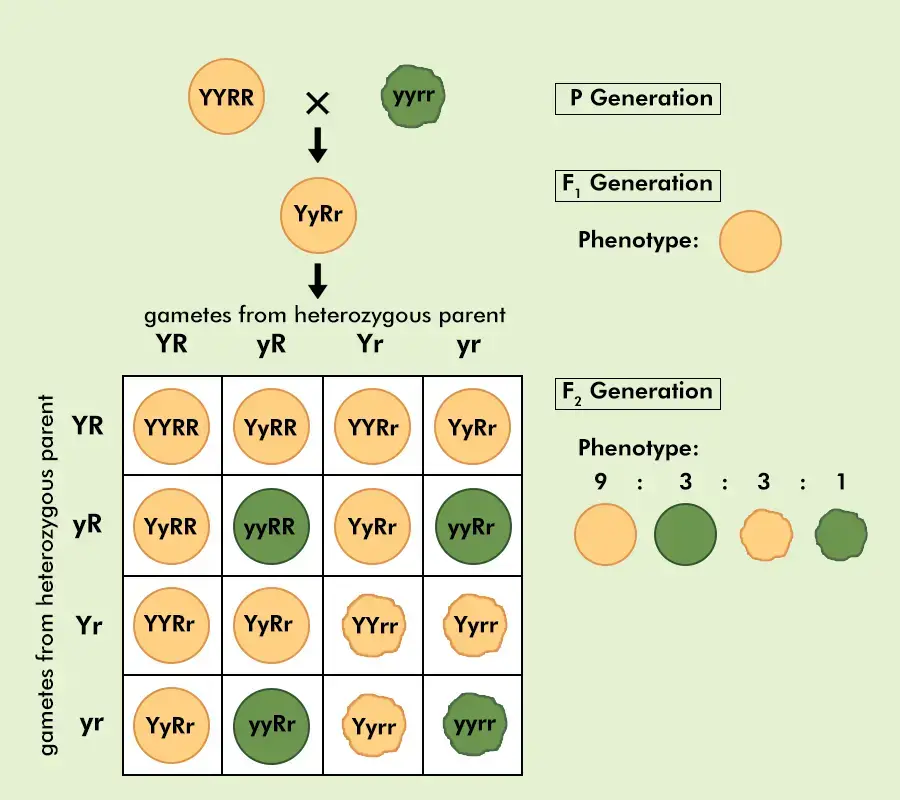
Explanation of Dihybrid Cross
A dihybrid cross is a type of genetic experiment that involves the simultaneous study of the inheritance patterns of two different traits. This cross allows researchers to explore how two distinct traits are transmitted from parents to offspring and how they assort independently of each other. The dihybrid cross builds upon the principles established in the monohybrid cross and provides insights into the inheritance of multiple traits simultaneously.
Here’s a step-by-step explanation of a dihybrid cross:
- Parental Generation (P): Similar to the monohybrid cross, two individuals that differ in two specific traits are selected as parents. These individuals constitute the parental generation (P). Let’s consider two traits: seed color (yellow, YY or green, yy) and seed shape (round, RR or wrinkled, rr) in pea plants.
- Allele Combinations: Each parent contributes one allele for each of the two traits to the offspring. In our example, one parent could contribute a YYRR genotype (yellow and round seeds), while the other parent could contribute a yyrr genotype (green and wrinkled seeds).
- First Filial Generation (F1): The offspring resulting from the cross between the parental individuals make up the first filial generation (F1). In a dihybrid cross, all F1 offspring will inherit one allele for each trait from each parent. In our example, all F1 pea plants will have a genotype of YyRr, combining one dominant and one recessive allele for each trait.
- Trait Expression in F1: The F1 generation will express the dominant traits for both traits, as the dominant alleles mask the effects of the recessive alleles. In our example, all F1 pea plants will have yellow and round seeds.
- Second Filial Generation (F2): Members of the F1 generation are allowed to mate with each other to produce the second filial generation (F2), where the complexity of trait combinations becomes apparent.
- Trait Assortment in F2: When F1 individuals with the genotype YyRr (heterozygous for both traits) are crossed with each other, their offspring in the F2 generation will have a variety of possible allele combinations. This is due to the independent assortment of alleles for each trait during gamete formation.
- Phenotypic Ratio in F2: The F2 generation will display a phenotypic ratio that reflects the various combinations of alleles. In a dihybrid cross, the phenotypic ratio is typically 9:3:3:1. This means that on average, 9/16 of the offspring will display both dominant traits, 3/16 will display one dominant trait and one recessive trait, 3/16 will display the other dominant trait and one recessive trait, and 1/16 will display both recessive traits.
The dihybrid cross reveals how genes for two different traits assort independently of each other during gamete formation, leading to a multitude of possible allele combinations in the offspring. This experiment showcases the complexity of genetic interactions and helps researchers understand how different traits are inherited together within populations.
Mendel’s Laws of Inheritance or Mendel’s Principles of Inheritance
Gregor Mendel, the pioneering geneticist, formulated three fundamental laws that unravel the intricate mechanisms governing the inheritance of traits within organisms. These laws, known as Mendel’s Laws of Inheritance, laid the cornerstone for modern genetics and continue to provide the framework for understanding the transmission of genetic traits.
1. Law of Dominance
The Law of Dominance dictates that when an organism carries two different forms (alleles) of a specific trait, one of these alleles will be dominant, while the other will be recessive. In the context of a monohybrid cross involving two parents with differing alleles for a trait, the dominant allele takes precedence over the recessive one. As a result, in the first filial (F1) generation, only the dominant allele is expressed, while the recessive allele remains latent. This law illustrates how traits inherited from parents manifest in their offspring and offers a fundamental explanation for the consistent appearance of certain traits in successive generations during monohybrid crosses.
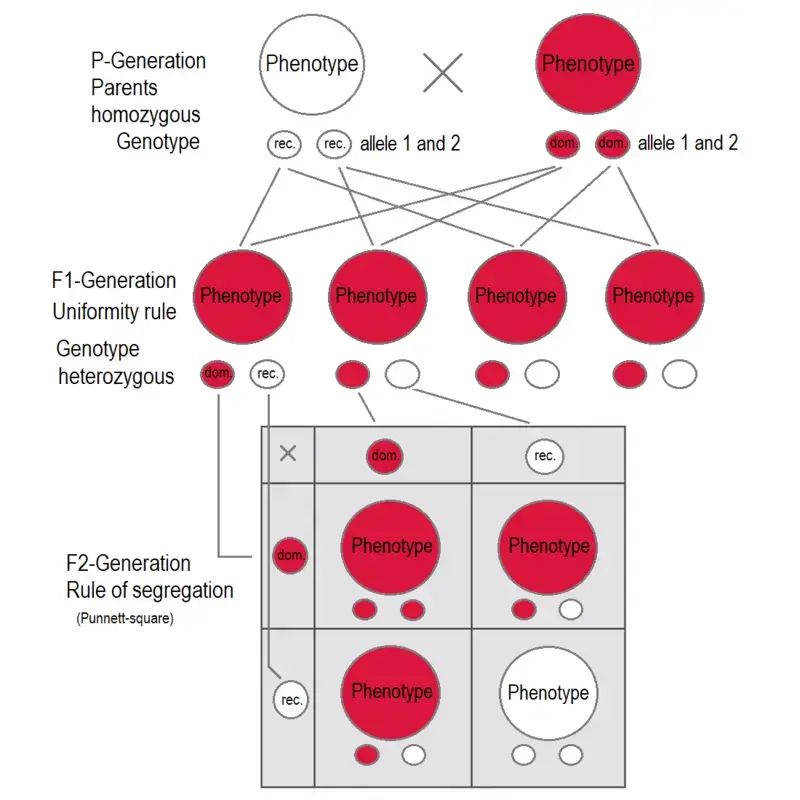
2. Law of Segregation
Also known as the Law of Purity of Gametes, the Law of Segregation elucidates the fate of alleles responsible for a given trait during the formation of gametes. Each individual possesses a pair of alleles for a particular trait, with one inherited from each parent. During gamete formation, these allele pairs segregate, resulting in each gamete carrying only one allele for a trait. Consequently, gametes become pure or homozygous for that specific trait. The Law of Segregation underscores the orderly distribution of alleles to offspring and underscores the basis for the genetic diversity present within populations.
3. Law of Independent Assortment
The Law of Independent Assortment states that alleles governing different traits assort and are inherited autonomously during the creation of gametes. This implies that the presence or absence of alleles for one trait is unaffected by the presence or absence of alleles for other traits. Mendel’s dihybrid cross experiments provide empirical support for this law, as he demonstrated that the inheritance of seed color and seed shape (two separate traits) occurred independently of each other. The Law of Independent Assortment highlights the non-linked inheritance of traits and is instrumental in understanding the variety of genetic combinations that arise in offspring due to the random assortment of alleles during gamete formation.
| Mendel’s Laws of Inheritance | Definition |
|---|---|
| Law of Dominance and Uniformity | This law states that certain alleles are dominant, while others are recessive. An organism possessing at least one dominant allele will express the dominant trait.[19] |
| Law of Segregation | According to this law, during the formation of gametes, alleles for each gene separate from one another, resulting in each gamete carrying only one allele for each gene. |
| Law of Independent Assortment | This law explains that genes controlling different traits can segregate independently during gamete formation. |
Mendel’s Laws of Inheritance have not only enriched our comprehension of genetic transmission but also set the stage for the development of modern genetics. These laws serve as the foundational principles that underlie genetic research, and they continue to guide scientists in deciphering the complexities of inheritance, variation, and heredity in the biological world.
Let’s explore each of Mendel’s Laws of Inheritance with examples to provide a clearer understanding:
1. Law of Dominance: The Law of Dominance states that when an organism carries two different alleles for a particular trait, one allele will be dominant and the other recessive. The dominant allele will determine the trait’s appearance, while the recessive allele will be masked in the presence of the dominant allele.
Example: Consider the trait of flower color in pea plants. Let’s say that the allele for purple flowers (P) is dominant over the allele for white flowers (p). When a purple-flowered pea plant (PP) is crossed with a white-flowered pea plant (pp), the offspring in the F1 generation will all have purple flowers (Pp). Here, the dominant allele (P) is expressed, while the recessive allele (p) remains hidden.
2. Law of Segregation: The Law of Segregation states that alleles for a specific trait segregate or separate during the formation of gametes, ensuring that each gamete carries only one allele for that trait.
Example: Continuing with the flower color trait, let’s follow the F1 generation (Pp) from the previous example. When these F1 plants are allowed to self-pollinate, they produce gametes. Each gamete receives one allele from the pair. So, half of the gametes will carry the dominant allele (P), and the other half will carry the recessive allele (p). This ensures that during fertilization, each offspring receives one allele from each parent, restoring the allele pairs.
3. Law of Independent Assortment: The Law of Independent Assortment states that alleles for different traits assort independently of each other during gamete formation, and the inheritance of one trait does not influence the inheritance of another trait.
Example: Let’s expand the example to two traits: flower color (purple or white) and seed shape (round or wrinkled). According to the Law of Independent Assortment, the alleles for these two traits will assort independently. So, if you have a pea plant with the genotype PpRr (purple flowers and round seeds) and cross it with another PpRr plant, the F1 generation’s possible combinations will be PR, Pr, pR, and pr. Each combination occurs with equal probability, showing that the inheritance of flower color doesn’t affect the inheritance of seed shape.
These examples illustrate how Mendel’s Laws of Inheritance work in explaining the patterns of genetic traits in offspring. The Law of Dominance determines which alleles are expressed, the Law of Segregation explains how alleles are separated during gamete formation, and the Law of Independent Assortment clarifies how alleles for different traits assort independently in offspring.
Law of Segregation vs. Law of Independent Assortment
The Law of Segregation and the Law of Independent Assortment are fundamental principles of Mendelian inheritance that describe the behavior of alleles during the process of gamete formation and the inheritance of multiple traits. Here’s a breakdown of these two laws:
Law of Segregation: The Law of Segregation, also known as the Law of Purity of Gametes, governs how alleles for a particular trait separate during the formation of gametes (sperm and egg cells). It was discovered by Gregor Mendel through his experiments with pea plants. This law emphasizes that:
- During meiosis, the process of gamete formation, each parent contributes one allele for a specific trait to each offspring.
- The alleles carried by an individual for a particular trait segregate from each other during gamete formation, so that each gamete carries only one allele for that trait.
- This ensures that when fertilization occurs, the offspring inherit one allele from each parent, resulting in the genetic diversity and variability necessary for evolution.
- The segregation of alleles is random and unbiased, meaning that neither allele has an advantage or is favored during the separation process.
Law of Independent Assortment: The Law of Independent Assortment describes how alleles for different traits segregate and assort independently of each other during gamete formation. This principle is closely related to the distribution of alleles from different genes into gametes. Key points of this law include:
- Alleles located on different chromosomes assort independently, meaning that the inheritance of one trait does not influence the inheritance of another trait.
- The independent assortment occurs due to the random alignment of homologous chromosomes along the metaphase plate during meiosis I.
- The possible combinations of alleles in gametes are numerous, leading to increased genetic diversity in the offspring.
- This law contributes to the uniqueness of each individual and the variability within populations.
In summary, the Law of Segregation emphasizes the separation of alleles for a single trait during gamete formation, ensuring each offspring inherits one allele from each parent. The Law of Independent Assortment underscores the random and independent distribution of alleles for different traits into gametes, resulting in diverse combinations of traits in offspring. Both laws play a crucial role in shaping the genetic diversity within populations and are essential for understanding inheritance patterns in organisms.
| Law of Segregation | Law of Independent Assortment |
|---|---|
| Definition: | Definition: |
| Alleles for a specific trait | Alleles for different traits segregate |
| segregate during gamete formation. | and assort independently during gamete |
| formation. | |
| Process: | Process: |
| During meiosis, each parent | During meiosis I, alleles located on |
| contributes one allele for a | different chromosomes align independently |
| specific trait to each offspring. | along the metaphase plate. |
| Outcome: | Outcome: |
| Offspring inherit one allele from | Genetic diversity is increased in |
| each parent for a particular trait. | offspring due to numerous combinations |
| of alleles in gametes. | |
| Randomness: | Randomness: |
| Segregation of alleles is random | Independent assortment leads to random |
| and unbiased; neither allele is | combinations of alleles in gametes, |
| favored during separation. | without influence from other traits. |
In summary, the Law of Segregation emphasizes the separation of alleles for a single trait during gamete formation, while the Law of Independent Assortment underscores the random and independent distribution of alleles for different traits into gametes. Both laws contribute to genetic diversity and are crucial for understanding inheritance patterns.
Pedigrees to Study Inheritance Patterns
Pedigree analysis is a valuable tool used by geneticists to study the inheritance patterns of human genetic diseases. It provides insights into how traits are passed down through generations within families, helping individuals understand their risk of inheriting or passing on specific genetic disorders.
Understanding Genetic Inheritance:
- Many human diseases have a genetic basis, meaning they are caused by specific gene mutations inherited from parents.
- For individuals in families with a history of genetic disorders, it’s important to determine if they carry disease-causing genes and assess the risk of passing the disorder to their children.
- Inherited disorders can follow different patterns of inheritance, including autosomal recessive, autosomal dominant, X-linked recessive, and others.
Pedigree Analysis:
- Pedigrees are visual representations of family trees that track the occurrence of specific traits or disorders across generations.
- In pedigrees, each generation is represented by a row, and individuals are depicted using symbols (circles for females, squares for males).
- Relationships between individuals are shown with connecting lines, indicating marriages and parent-offspring relationships.
- Pedigrees allow geneticists to analyze patterns of inheritance, identify carriers of disease-causing alleles, and predict the likelihood of an individual being affected by a genetic disorder.
Pedigree Components:
- Affected Individuals: Those with the genetic disorder are represented by shaded symbols. The presence of the disorder in an individual’s lineage is indicated by a shaded circle or square.
- Carriers: Individuals who carry a disease-causing allele but do not exhibit symptoms are represented by half-shaded symbols (half-filled circles or squares).
- Unaffected Individuals: Those without the genetic disorder are depicted with clear symbols.
- Generations: Rows in the pedigree represent different generations of the family, with the oldest generation at the top.
- Relationships: Horizontal lines connect mating partners, and vertical lines extend downward to connect parents with their offspring.
Interpreting Pedigrees:
- Pedigrees reveal inheritance patterns, helping geneticists determine if a disorder is recessive, dominant, or X-linked.
- Autosomal Recessive: Typically appears in multiple generations, skips generations, and affects males and females equally.
- Autosomal Dominant: Appears in each generation, affects males and females equally, and often has an affected parent.
- X-Linked Recessive: More common in males, can skip generations, and is often passed from carrier females to their sons.
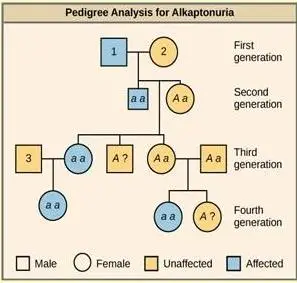
Alkaptonuria is a recessive genetic disorder that impairs the metabolism of phenylalanine and tyrosine amino acids. Affected individuals can exhibit darkened skin, brown urine, and may suffer from joint damage and other complications. A pedigree illustrates the inheritance of this disorder, where affected individuals are shown in blue and have the genotype aa, while unaffected individuals are depicted in yellow with the genotypes AA or Aa.
Key Points:
- Alkaptonuria is a recessive genetic disorder causing issues with phenylalanine and tyrosine metabolism.
- Affected individuals can display skin darkening, brown urine, joint problems, and other complications.
- Pedigrees visually represent family inheritance patterns, aiding the study of genetic disorders.
- Affected individuals are indicated in blue and have the aa genotype (homozygous recessive).
- Unaffected individuals are depicted in yellow and can have either AA (homozygous dominant) or Aa (heterozygous) genotypes.
- Genotypes of individuals can be inferred from those of their offspring.
- If a child has the disorder but neither parent does, both parents must be heterozygous carriers (Aa).
- Individuals with an unaffected phenotype but unknown genotype are represented as “A?” since they must have at least one normal allele.
This pedigree highlights how analyzing family trees can provide insights into genetic disorders’ inheritance patterns and aid in determining the genotypes of individuals based on the traits they pass down to their offspring.
Example:
- A pedigree for a human genetic disease illustrates how the disorder is passed down through generations.
- Affected individuals are shaded, carriers are half-shaded, and unaffected individuals are clear.
- Relationships are depicted through connecting lines, highlighting parent-offspring and marital connections.
Pedigree analysis plays a crucial role in understanding genetic disorders within families and communities. By studying the patterns of inheritance, geneticists can provide valuable information for individuals making informed decisions about their health and family planning.
Non-Mendelian inheritance
- Non-Mendelian inheritance refers to the inheritance patterns of traits that deviate from the expectations set by Mendel’s laws. These laws, proposed by Gregor Mendel, outline how traits associated with single genes on chromosomes within the nucleus segregate during reproduction. In Mendelian inheritance, each parent contributes one of two possible alleles for a trait to their offspring. By knowing the genotypes of the parents in a genetic cross, Mendel’s laws can predict the distribution of phenotypes among their offspring. However, there are instances where the observed proportions of phenotypes in the progeny differ from the predicted values.
- Non-Mendelian inheritance scenarios challenge these straightforward predictions and encompass various mechanisms that influence trait transmission. These mechanisms often involve complex genetic interactions, such as multiple genes affecting a single trait, or genetic traits being influenced by factors beyond nuclear DNA.
- Non-Mendelian inheritance plays a significant role in several genetic diseases and conditions. Some disorders are caused by mutations in genes that don’t adhere to Mendelian inheritance patterns, making the inheritance and expression of these traits more intricate. Additionally, certain diseases are impacted by factors such as mitochondrial DNA, genomic imprinting, or polygenic inheritance, all of which lead to deviations from classical Mendelian ratios.
- In summary, non-Mendelian inheritance encompasses a wide array of genetic scenarios that don’t conform to the simple rules of Mendel’s laws. These complex genetic interactions are vital to understanding the full spectrum of inheritance patterns, especially in cases where diseases and conditions are influenced by a combination of genetic factors beyond the scope of Mendelian genetics.
Types
Non-Mendelian inheritance encompasses various patterns of genetic inheritance that do not adhere to the straightforward principles outlined by Mendel’s laws. These deviations introduce complexity to the understanding of how traits are passed down from one generation to the next. Several types of non-Mendelian inheritance are recognized, each involving unique genetic interactions:
- Incomplete Dominance: Incomplete dominance challenges the principle of dominance proposed by Mendel. Instead of a dominant allele fully masking the recessive allele, both alleles contribute to the phenotype, resulting in an intermediate expression. For example, in Mirabilis jalapa and Antirrhinum majus, flower color demonstrates incomplete dominance.
- Co-dominance: Co-dominance defies the traditional dominance-recessiveness relationship between alleles. Both alleles are equally expressed in the phenotype, allowing both traits to be observed simultaneously. Co-dominance is exemplified by certain chicken varieties with co-dominant alleles for black and white feathers, as well as the ABO blood group system in humans.
- Genetic Linkage: Genetic linkage deviates from Mendel’s principle of independent assortment. When genes are located near each other on the same chromosome, they tend to be inherited together, which contradicts the expected independent segregation of alleles during meiosis.
- Multiple Alleles: Multiple alleles involve genes that possess more than two variations within a population. Unlike Mendel’s experiments that focused on traits regulated by only two alleles, multiple alleles demonstrate the existence of several different forms of a gene. The ABO blood group system in humans, with its three alleles (A, B, and O), illustrates multiple alleles.
- Epistasis: Epistasis involves the interaction of multiple genes, where one gene’s expression influences or masks the expression of another gene. This contrasts with Mendel’s laws, as it showcases the interconnectedness of genetic pathways and how the expression of one gene can modify another gene’s expression.
- Sex-Linked Inheritance: Genetic traits located on sex chromosomes exhibit specific non-Mendelian patterns. Sex-linked inheritance encompasses traits influenced by genes on the X and Y chromosomes, affecting males and females differently. Examples include color blindness and hemophilia.
- Extranuclear Inheritance (Cytoplasmic Inheritance): Extranuclear inheritance involves genetic information present in organelles like mitochondria and chloroplasts, which is passed down through the cytoplasm of maternal gametes. Disorders like mitochondrial diseases exemplify this mode of inheritance.
- Polygenic Traits: Polygenic traits result from the interaction of multiple genes and exhibit a wide range of phenotypes. Skin color and eye color in humans are examples of polygenic traits influenced by multiple genes.
- Genomic Imprinting: Genomic imprinting involves genes that are marked epigenetically before transmission, altering their expression levels. Imprints are created before gamete formation and can result in the exclusive expression of certain alleles depending on parental origin.
- Trinucleotide Repeat Disorders: Trinucleotide repeat disorders, such as Fragile X syndrome and Huntington’s disease, result from the expansion of microsatellite tandem repeats. These disorders display non-Mendelian inheritance patterns as the number of repeats changes across generations.
These diverse forms of non-Mendelian inheritance underscore the intricate genetic interactions that shape the inheritance of traits and contribute to the complexity of genetic inheritance patterns beyond Mendel’s classical laws.
Modes of Inheritance
Modes of Inheritance delineate the various patterns through which genetic traits are transmitted across generations. Mendelian inheritance, which follows Gregor Mendel’s foundational principles, encompasses three primary modes: autosomal dominant, autosomal recessive, and X-linked inheritance.
1. Autosomal Dominant Inheritance: Autosomal dominant inheritance entails a scenario where the presence of a single dominant allele is adequate to express a trait or disease, even if the corresponding allele on the other chromosome is normal. This implies that an affected individual requires only one copy of the dominant allele from either parent to manifest the trait or disease. This mode exhibits a 50% likelihood of passing the trait to each independent offspring.
Example: Consider Huntington’s disease. If an individual inherits a single copy of the dominant allele from either parent, they will express the disease. If one parent has the disease and the other does not, their offspring have a 50% chance of inheriting the disease-causing allele.
2. Autosomal Recessive Inheritance: Autosomal recessive inheritance mandates the presence of two abnormal recessive alleles— one from each parent— for the expression of a trait or disease. In this pattern, both alleles must be anomalous for the trait to manifest. Carriers with one copy of the recessive allele do not exhibit the trait but can pass it on to their offspring. When both parents are carriers, they face a 25% risk of having an affected child.
Example: Cystic fibrosis exemplifies autosomal recessive inheritance. For an individual to have cystic fibrosis, they must inherit a mutated allele from both parents. Carrier parents, each with one mutated allele, do not have the disease themselves but can have affected offspring if both mutated alleles are passed on.
3. X-Linked Inheritance: X-linked inheritance pertains to traits or diseases governed by genes situated on the X chromosome. Males, possessing one X and one Y chromosome, typically exhibit X-linked traits inherited from their mother, as they inherit their single X chromosome from her. In contrast, females, with two X chromosomes, can be carriers of X-linked traits without manifesting the phenotype.
Example: Hemophilia, an X-linked disorder, primarily affects males. If a mother is a carrier (carries one normal and one mutated allele) for hemophilia and the father has a normal allele, their sons have a 50% chance of inheriting the disease. Daughters of carrier mothers have a 50% chance of being carriers themselves.
These modes of inheritance illustrate the diverse ways genetic traits are transmitted and manifest within populations. By understanding these patterns, scientists and medical professionals gain insights into the hereditary basis of various traits and diseases, contributing to advancements in genetics, diagnosis, and treatment.
Exceptions and Deviation from Mendel’s Findings
Mendel’s pioneering work in genetics laid a solid foundation for understanding inheritance patterns. However, as research has progressed, exceptions and deviations from Mendel’s findings have emerged, enriching our comprehension of the complexities inherent in genetic inheritance. These exceptions highlight the diverse and intricate nature of genetic interactions. Some of these deviations include:
- Incomplete Dominance: In cases of incomplete dominance, the offspring’s phenotype is neither identical to that of either parent nor purely dominant. Instead, it lies between the phenotypes of the parents. This phenomenon arises when one allele doesn’t fully dominate over the other, leading to a blending of the traits associated with both alleles. This contradicts Mendel’s Law of Dominance, which states that one allele is dominant and suppresses the expression of the other. An example can be found in snapdragon flowers, where crossing red and white flowered plants results in pink flowers.
- Co-dominance: Co-dominance arises when both alleles in an organism are equally and fully expressed. In this scenario, neither allele exerts dominance over the other, and both traits are simultaneously observable in the phenotype. Unlike Mendel’s Law of Dominance, where one allele masks the other’s effects, co-dominance showcases the harmonious coexistence of both traits. Blood type inheritance illustrates this phenomenon, where the A and B alleles are co-dominant, giving rise to individuals with both A and B antigens.
- Multiple Alleles: Multiple alleles pertain to a gene having more than two distinct variations or alleles within a population. This contrasts Mendel’s experiments, which focused on traits regulated by only two alleles. Some traits exhibit multiple alleles, demonstrating the diverse range of genetic variation. The ABO blood group system, for instance, boasts three alleles: A, B, and O.
- Genetic Linkage: Genetic linkage is the tendency of genes located close to one another on the same chromosome to be inherited together, in contrast to Mendel’s principle of independent assortment, which posits that genes segregate independently. Genetic linkage underscores the physical proximity of genes on chromosomes and how they might not assort independently due to their close proximity.
- Epistasis: Epistasis occurs when the expression of one gene affects or masks the expression of another gene. This deviates from Mendel’s laws, as it involves the intricate interaction of multiple genes. Epistasis illustrates that the expression of one gene can modify or influence the expression of another, highlighting the interconnectedness of genetic pathways.
These deviations from Mendel’s findings showcase the intricacies of genetic inheritance beyond the simple dominant and recessive traits he studied. They illuminate the complex interactions between alleles, genes, and chromosomes, contributing to a more nuanced and comprehensive understanding of genetics.
Importance of Mendelian Inheritance
Mendelian inheritance, also known as Mendelism or Mendelian genetics, holds significant importance in the field of biology and genetics for several reasons:
- Foundation of Genetics: Mendel’s experiments with pea plants laid the groundwork for understanding the principles of heredity and how traits are passed from one generation to another. His work marked the beginning of modern genetics.
- Predictive Power: Mendelian inheritance provides a framework for predicting the likelihood of specific traits appearing in offspring based on the genotypes of the parents. This predictability is crucial in agriculture, animal breeding, and even in human genetics for genetic counseling.
- Basis for Genetic Studies: Mendel’s laws serve as a starting point for studying various genetic phenomena, including linkage, recombination, and mutation. These laws help scientists decipher the mechanisms underlying genetic traits and diseases.
- Clinical Relevance: Understanding Mendelian inheritance is essential for diagnosing and treating genetic disorders. It allows for the prediction of inheritance patterns, carrier status, and risk assessment for certain diseases in individuals and families.
- Population Genetics: Mendelian principles play a role in population genetics and evolutionary biology. They contribute to the understanding of how traits can change over time in a population through mechanisms like natural selection.
- Basis for Genetic Research: Mendelian inheritance provided the foundation for subsequent genetic research, including the discovery of DNA as the genetic material and the development of techniques such as polymerase chain reaction (PCR) and gene sequencing.
- Genetic Engineering: The understanding of Mendelian genetics has paved the way for genetic engineering and biotechnology. Scientists can manipulate genes and organisms based on these principles, leading to advancements in agriculture, medicine, and other fields.
- Education and Outreach: Mendelian genetics is often introduced in basic biology education. It serves as an accessible way to introduce the concepts of inheritance, genes, and genetic variation to students of various ages.
- Ethical Considerations: The principles of Mendelian inheritance have implications for ethical discussions surrounding genetic testing, gene editing, and issues related to hereditary diseases.
- Building Blocks of Complex Traits: While Mendelian genetics describes simple inheritance patterns, understanding these foundational principles helps researchers unravel the genetics behind more complex traits, including those influenced by multiple genes and environmental factors.
In essence, Mendelian inheritance provides a framework for understanding the fundamental mechanisms of heredity, which underpin advancements in genetics, medicine, and biotechnology, ultimately shaping our understanding of life itself.
List of Latest Research Work on Mendelian Inheritance
- Alkaptonuria: Current Perspectives
- Abstract: This research delves into the metabolic disorder alkaptonuria (AKU), which is caused by a deficiency of homogentisate dioxygenase (HGD). Sir Archibald Garrod used AKU to illustrate the concept of Mendelian inheritance in man. The study highlights the phase III clinical study SONIA 2, which tested the effectiveness and safety of nitisinone in the treatment of AKU. The results were positive, suggesting that a cure for AKU might be found by 2020. The research also touches upon the potential of enzyme replacement or gene therapy for AKU.
- Authors: A. Zaťková, L. Ranganath, L. Kádasi
- Publication Date: 2020-01-23
- Link to Full Paper
- A stroke gene panel for whole-exome sequencing
- Abstract: This research aimed to compile a comprehensive panel of genes associated with monogenic causes of stroke. The study systematically searched the Online Mendelian Inheritance in Man database and validated the entries against peer-reviewed publications. The resulting gene panel can be used to interpret exome sequencing results regarding monogenic stroke.
- Authors: A. Ilinca, Sofie Samuelsson, P. Piccinelli, M. Soller, U. Kristoffersson, A. Lindgren
- Publication Date: 2018-10-24
- Link to Full Paper
- Gene and Variant Annotation for Mendelian Disorders in the Era of Advanced Sequencing Technologies
- Abstract: The paper discusses the trends in research that aims to increase understanding of overall genomic complexity, complex inheritance patterns of disease, and patient-phenotype-specific genomic associations. It describes the emerging field of translational functional genomics and its role in the future of personalized medicine.
- Authors: S. Chakravorty, M. Hegde
- Publication Date: 2017-08-31
- Link to Full Paper
- Analysis of Mendelian inheritance and genetic linkage in microsatellite loci of Eucalyptus urophylla S.T. Blake
- Abstract: The study verified Mendelian inheritance, genetic linkage, and genotypic disequilibrium for 15 microsatellite loci in Eucalyptus urophylla. The results indicated that the analyzed set of microsatellite loci could be used for various genetic analyses in E. urophylla.
- Authors: S. Pupin, L. Rosse, I. C. Souza, J. Cambuim, C. Marino, M. Moraes, A. Sebbenn
- Publication Date: 2017-08-17
- Link to Full Paper

Practice MCQ on Mendelian Inheritance
What term is used to describe discrete units of hereditary information that are passed on from parents to offspring?
a) Genes
b) Alleles
c) Chromosomes
d) Proteins
Gregor Mendel conducted his groundbreaking experiments using which organism?
a) Dogs
b) Pea plants
c) Bacteria
d) Mice
In Mendelian inheritance, what is a gene composed of?
a) DNA sequence
b) RNA sequence
c) Protein sequence
d) Carbohydrate sequence
What is the term for a specific variant of a gene?
a) Phenotype
b) Chromosome
c) Allele
d) Locus
An organism with two different alleles for a particular gene is known as:
a) Homozygous
b) Heterozygous
c) Dominant
d) Recessive
According to the Law of Segregation, what happens during gamete formation?
a) Alleles for a gene segregate into separate gametes
b) Alleles for a gene blend together
c) Genes for different traits segregate together
d) Homologous chromosomes stay together
In a heterozygous individual, which allele’s phenotype is expressed?
a) Dominant allele
b) Recessive allele
c) Both alleles’ phenotypes are expressed equally
d) Neither allele’s phenotype is expressed
A person with the genotype Aa for a specific gene exhibits the dominant phenotype. What is the genotype of the individual’s parents?
a) AA and aa
b) Aa and Aa
c) Aa and aa
d) AA and Aa
What is the term for a gene that masks the expression of another gene?
a) Recessive gene
b) Dominant gene
c) Homozygous gene
d) Heterozygous gene
In Mendelian inheritance, when does co-dominance occur?
a) When one allele completely masks the expression of another
b) When two alleles are equally expressed in the phenotype
c) When one allele blends with another in the phenotype
d) When multiple alleles interact to produce a single phenotype
Answers:
a) Genes
b) Pea plants
a) DNA sequence
c) Allele
b) Heterozygous
a) Alleles for a gene segregate into separate gametes
a) Dominant allele
b) Aa and Aa
b) Dominant gene
b) When two alleles are equally expressed in the phenotype
FAQ
What is Mendelian inheritance?
Mendelian inheritance, also known as Mendelism, refers to the set of principles proposed by Gregor Mendel that explains how hereditary traits are passed from parents to their offspring through the transmission of genes.
Who was Gregor Mendel?
Gregor Mendel was an Austrian monk and botanist who conducted pioneering experiments with pea plants in the 19th century, leading to the formulation of the fundamental laws of inheritance now known as Mendel’s principles.
What are the three laws of Mendelian inheritance?
The three laws are the Law of Dominance, the Law of Segregation, and the Law of Independent Assortment. These laws govern how alleles (gene variants) are inherited and determine the expression of traits in offspring.
How does the Law of Dominance work?
The Law of Dominance states that one allele (dominant) will mask the expression of another allele (recessive) for a particular trait. Only when an individual is homozygous recessive will the recessive trait be expressed.
Explain the Law of Segregation.
The Law of Segregation states that during the formation of gametes (sperm and egg cells), the alleles for a trait segregate or separate from each other. As a result, each gamete carries only one allele for a specific trait.
What is the Law of Independent Assortment?
The Law of Independent Assortment states that alleles for different traits segregate independently during gamete formation. This principle explains how traits are inherited without being influenced by the inheritance of other traits.
What is the difference between genotype and phenotype?
Genotype refers to the genetic makeup of an organism, including the combination of alleles it carries. Phenotype refers to the observable traits or characteristics that result from the interaction between an organism’s genotype and its environment.
What is the significance of dominant and recessive alleles?
Dominant alleles express their phenotype even in heterozygous individuals, while recessive alleles require homozygosity to manifest their phenotype. Dominant alleles mask the expression of recessive alleles in heterozygotes.
Can traits be influenced by multiple genes?
Yes, many traits are controlled by multiple genes, a phenomenon known as polygenic inheritance. These traits often display a wide range of phenotypes due to the cumulative effects of multiple gene variants.
Are there exceptions to Mendelian inheritance?
Yes, there are instances of non-Mendelian inheritance, such as incomplete dominance, co-dominance, genetic linkage, and epistasis. These cases involve more complex inheritance patterns that deviate from the classical Mendelian principles.
References
- Harel, T., Pehlivan, D., Caskey, C. T., & Lupski, J. R. (2015). Mendelian, Non-Mendelian, Multigenic Inheritance, and Epigenetics. Rosenberg’s Molecular and Genetic Basis of Neurological and Psychiatric Disease, 3–27. doi:10.1016/b978-0-12-410529-4.00001-2
- “Principles of Genetics” by D. Peter Snustad and Michael J. Simmons
- “Introduction to Genetic Analysis” by Anthony J.F. Griffiths, Susan R. Wessler, Sean B. Carroll, and John Doebley
- “Genetics: Analysis and Principles” by Robert J. Brooker
- “Essentials of Genetics” by William S. Klug, Michael R. Cummings, Charlotte A. Spencer, and Michael A. Palladino
- “Molecular Biology of the Cell” by Bruce Alberts, Alexander Johnson, Julian Lewis, David Morgan, Martin Raff, Keith Roberts, and Peter Walter
- https://knowgenetics.org/mendelian-genetics/
- https://www.biologyonline.com/dictionary/mendelian-inheritance
- https://bioprinciples.biosci.gatech.edu/module-4-genes-and-genomes/4-2-4-mendelian-genetics/
- https://rwu.pressbooks.pub/bio103/chapter/mendelian-genetics/
- https://en.wikipedia.org/wiki/Mendelian_inheritance








